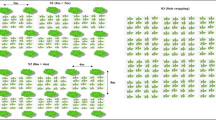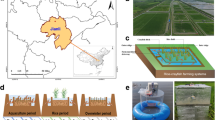Abstract
Irrigation of residential and commercial lawns in excess of plant water requirements can result in waste of potable water supply and negative public perception regarding turf landscapes. A 3-year field study was conducted to evaluate simple historical ETo-based irrigation scheduling for maintenance of St. Augustinegrass [Stenotaphrum secundatum (Walt.) Kuntze ‘Raleigh’] lawns in College Station, TX, USA. Whole main plots were assigned crop coefficients of 1.00, 0.60, 0.36, or 0.24 (K100, K60, K36, and K24) used to adjust historical ETo (47-year average). Sub-plots received N rates of either 0.0, 0.4, or 0.8 kg ha−1 month−1 during the experimental period each year. Irrigation treatments were applied 3 days per week from July through September each year. Acceptable turf quality was maintained when irrigation depths were ≥47% of actual ETo. The K60 treatment provided adequate irrigation for turf performance but caused 31% overwatering in the wettest year. The K36 treatment resulted in acceptable turf quality not only in the wettest year, but also showed complete recovery of the turf sward by the end of fall in each year. This research has outlined a simple and effective method for conserving water used to irrigate St. Augustinegrass lawns.



Similar content being viewed by others
References
Allen RG, Pereira LS, Raes D, Smith M (1998) Crop evapotranspiration: Guidelines for computing crop water requirements. Irr & Drain. Paper 56. UN-FAO, Rome, Italy
Barton L, Wan GGY, Buck RP, Colmer TD (2009) Nitrogen increases evapotranspiration and growth of a warm-season turfgrass. Agron J 101:17–24
Bremer D, Keeley S, Jager A, Fry J, Lavis C (2012) In-ground irrigation systems affect lawn-watering behaviors of residential homeowners. Hort Technol 22(5):651–658
Cardenas-Lailhacar B, Dukes MD, Miller GL (2008) Sensor-based automation of irrigation on bermudagrass, during wet weather conditions. J Irr Drain Eng 134:120–128
Carrow RN (1995) Drought resistance aspects of turfgrasses in the southeast: evapotranspiration and crop coefficients. Crop Sci 35(6):1685–1690
Dukes, MD, Haley, MH, Hanks, SA (2006) Sprinkler irrigation and soil moisture uniformity. Proceedings of the 27th Annual Irrigation Show, San Antonio, TX, November 5–7, 2006
Ebdon JS, Petrovic AM, White RA (1999) Interaction of nitrogen, phosphorus, and potassium on evapotranspiration rate and growth of Kentucky bluegrass. Crop Sci 39:209–218
Feldhake CM, Danielson RE, Butler JD (1983) Turfgrass evapotranspiration. I. Factors influencing rate in urban environments. Agron J 75:824–830
Fontanier, CH, Aitkenhead-Peterson, JA, Wherley, BG, White, RH, Thomas, JC, Dwyer, P (in review) Deficit irrigation and fertility effects on NO3–N exports from St. Augustinegrass. J Environ Qual
Grabow GL, Ghali IE, Huffman RL, Miller GL, Bowman D, Vasanth A (2013) Water application efficiency and adequacy of ET-based and soil moisture-based irrigation controllers for turfgrass irrigation. J Irr Drain Eng 139(2):113–123
Hejl RW, Wherley BG, White RH, Thomas JC, Fontanier CH (2016) Deficit irrigation and simulated traffic on ‘Tifway’ bermudagrass summer performance and autumn recovery. Crop Sci 56:809–817
Hermitte SM, Mace RE (2012) The grass is always greener. Outdoor residential water use in Texas. Texas Water Development Board. Technical Note. 12–01
Irrigation Association (2005) Landscape irrigation scheduling and water management. Irrigation Association Water Management Committee Falls Church, VA, p 190
Kjelgren R, Rupp L, Kilgren D (2000) Water conservation in urban landscapes. HortScience 35(6):1037–1040
Kneebone WR, Pepper IL (1982) Consumptive water use by sub-irrigated turfgrasses under desert conditions. Agron J 74(3):419–423
Kopp KL, Guillard K (2002) Clipping management and nitrogen fertilization of turfgrass. Crop Sci 42:1225–1231
McCready MS, Dukes MD (2011) Landscape irrigation scheduling efficiency and adequacy by various control technologies. Ag Water Manage 98:687–704
McGroary PC, Cisar JL, Snyder GH, Erickson JE, Daroub SH, Sartain JB (2011) Water use of St. Augustinegrass and bahiagrass under varying nitrogen rates. Agron J 103(1):100–106
Meyer JL, Gibeault VA, Youngner VB (1985) Irrigation of turfgrass below replacement of evapotranspiration as a means of water conservation: determining crop coefficient of turfgrasses. In: F. Lemaire (ed.) Proc. 5th Intl. Turfgrass Research Conf., Avignon, France, July 1985. INRA Publications, Versailles, France. pp. 357–364
Morris K, Shearman R (1998) NTEP turfgrass evaluation guidelines. National Turfgrass Evaluation Program. Beltsville, MD. Online at http://www.ntep.org/pdf/ratings.pdf. Accessed 9 Mar 2017
Pannkuk TR, White RH, Steinke K, Aitkenhead-Peterson JA, Chalmers DR, Thomas JC (2010) Landscape coefficients for single-and mixed-species landscapes. HortScience 45(10):1529–1533
Peacock CH, Dudeck AE (1985) Effect of irrigation interval on St. Augustinegrass rooting. Agron J 77:813–815
Pope CN, Fipps G (2000) Potential evapotranspiration for irrigation water management in urban landscapes—the San Antonio experience. In: Proceedings of the 4th Decennial Symposium. ASAE. Phoenix, AZ
Qian YL, Engelke ME (1999) Performance of five turfgrasses under linear gradient irrigation. Hort Sci 34:893–896
Richardson MD, Karcher DE, Purcell LC (2001) Quantifying turfgrass cover using digital image analysis. Crop Sci 41(6):1884–1888
Steinke K, Chalmers D, Thomas J, White R, Fipps G (2010) Drought response and recovery characteristics of St. Augustinegrass cultivars. Crop Sci 50(5):2076–2083
Steinke K, Chalmers DR, White RH, Fontanier CH, Thomas JC, Wherley BG (2013) Lateral spread of three warm-season turfgrass species as affected by prior summer water stress at two root zone depths. Hort Sci 48(6):790–795
Texas Parks and Wildlife Department (2016) Save your yard. The State of Water. Online at http://www.texasthestateofwater.org/resources/yard.php. Accessed 9 Mar 2017
Texas Water Development Board (2012) Texas State Water Plan. Online at https://www.twdb.texas.gov/waterplanning/swp/2012/. Accessed 9 Mar 2017
Trenholm LE, Unruh JB (2007) St. Augustinegrass fertilizer trials. J Plant Nutrition 30(3):453–461
United States Environmental Protection Agency (2011) WaterSense specification for weather-based irrigation controllers. Online at http://www.epa.gov/watersense/docs/final_controller_specification_102611_final508.pdf. Accessed 10 Mar 2017
Vickers A (1991) The emerging demand-side era in water management. JAWRA 83(10):38–43
Weier KL, Doran JW, Power JF, Walters DT (1993) Denitrification and the dinitrogen/nitrous oxide ratio as affected by soil water, available carbon, and nitrate. Soil Sci Soc Am J 57:66–72
Wherley B, Dukes MD, Cathey S, Miller G, Sinclair T (2015) Consumptive water use and crop coefficients for warm-season turfgrass species in the Southeastern United States. Ag Water Manage 156:10–18
White R, Havlak R, Nations J, Pannkuk T, Thomas J, Chalmers D, Dewey D (2004) How much water is ‘enough’? Using PET to develop water budgets for residential landscapes. Texas Water Resources Institute TR-271:1–8
Acknowledgements
This project was funded by the Texas Turfgrass Research, Education, and Extension Endowed grant program.
Author information
Authors and Affiliations
Corresponding author
Ethics declarations
Conflict of interest
The authors declare that they have no conflict of interest.
Additional information
Communicated by L. Testi.
Rights and permissions
About this article
Cite this article
Fontanier, C., Wherley, B., White, R. et al. Historical ETo-based irrigation scheduling for St. Augustinegrass Lawns in the South-Central United States. Irrig Sci 35, 347–356 (2017). https://doi.org/10.1007/s00271-017-0544-x
Received:
Accepted:
Published:
Issue Date:
DOI: https://doi.org/10.1007/s00271-017-0544-x




